India: Poverty Retreats with Globalization’s Advance
India: Poverty Retreats with Globalization’s Advance
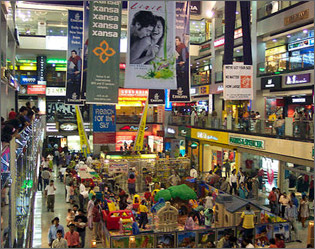
Enlarged image
MONTREAL: As the driving force of the world economy since the mid-1970s, globalization has become a lodestone for a wide-ranging attack across a large expanse of the developing world for its alleged malign consequences. Reduced to its essentials, the attack posits the impact of globalization to be economic stagnation, deindustrialization, economic destabilization and growing inequality.
Marked by vigor, the critique lacks in empirical rigor. Whatever the merits of this critique for the rest of the developing world, the empirical evidence from India, both quantitative and qualitative, constitutes an emphatic refutation. India forms a valuable test case by virtue of its vast size, huge population and rampant diversity. Put simply, India has been a significant beneficiary of globalization despite its rather modest integration into the world economy.
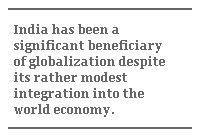
After a stringent regime of “autarky and command and control economy,” from 1956 to 1975, India started on a slow path of reintegration into the world economy, albeit in nascent form. Interestingly, India’s reintegration coincides with the onset of the larger process of globalization. However, carried out in stealth, economic liberalization, the national policy counterpart of globalization, remained tentative and minimal in India. Not until 1991 did India, amidst enormous economic crisis, make a paradigm shift to liberalization, though still limited.
Empirical comparison of the period before and after liberalization demonstrates that, instead of economic stagnation, India achieved a marked acceleration in economic growth after liberalization. Indeed, India broke the barrier of stagnation that had been the lot of the country before globalization. India’s rate of growth from 1975 to 2007 has been over 5.5 percent, compared to the derisively termed “Hindu” rate of growth of 3.4 percent over the period 1956 to 1975, and especially to the pathetic 2.6 percent over the decade prior to the nascent liberalization in 1975. In the dozen years from 1995 to 2007 the growth rate has been over 6.5 percent; during the last four years India has sustained an unprecedented average growth rate of over 8 percent.
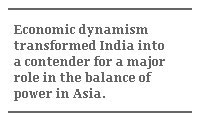
It is difficult to exaggerate this accomplishment in growth acceleration. It has provided additional resources not only for investment in human capital but also for expenditures on the social sectors and poverty alleviation. Besides, the economic dynamism associated with this growth has imparted a self-confidence for successfully building a consolidated nation-state. It has indeed transformed a country that had been mocked as “the sick man of Asia” – an inveterate supplicant for foreign aid – into a credible contender for a major role in the balance of power in Asia.
Similarly, far from the specter of deindustrialization held out by the critics, foreign imports have not swamped Indian industry after tariffs were lowered as part of India’s reintegration into the world economy. Rather, Indian industry has grown at a higher rate than it had prior to liberalization of the economy. The growth rate of manufacturing has been around 6.5 percent since 1975 and close to 7 percent during the dozen years up to 2006. At the latter rate, the value of manufacturing doubles about every 10 years – not exactly deindustrialization. The advance in manufacturing has been broad-based and not limited to consumption goods.
As regards denationalization, industry in India initially faced serious challenges from the entry of foreign multinationals. Yet foreign investment has served to supplement, not supplant Indian industry. India remains master of its economic destiny. Besides, under the invigorating impulses imparted by increased foreign competition, Indian industry reoriented its horizon beyond the domestic market to the wider world economy in terms of not only exports and establishment of subsidiaries but also of substantial, some indeed spectacular, purchases of foreign firms abroad. More recently, India has been on a course of “reverse imperialism” with its firms on a buying spree abroad. India is now the third largest investor in the UK.
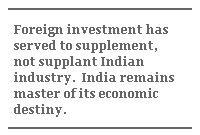
As for economic destabilization, the autarkic period prior to the initial and nascent opening to globalization in 1975 was ridden with grave economic crises. Indeed, throughout that entire period, India labored under an enormous and debilitating foreign-exchange constraint, which both retarded and distorted its development. The period of intermittent, incremental liberalization, 1974 to 1991, still saw some crises but the leadership used the occasions creatively to advance liberalization. After the paradigm shift to economic liberalization in the early 1990s, India has not yet seen another economic crisis and no longer faces a foreign-exchange constraint because of its accumulating reserves, currently at some $170 billion. The absence of a foreign-exchange crisis has boosted the self-confidence of the nation. The reserves had sunk to $1.2 billion during the 1991 crisis.
As for impoverishment, the globalization period has seen welfare enhancement through a long-term decline in poverty. The proportion of population below the poverty line was 55 percent in 1973, after which there has occurred a secular decline. By 2000 it stood at 26 percent. Although the last figure is disputed because of changes in survey design, there can be no doubt about the long-term decline. The line of causality here clearly runs from globalization and liberalization to acceleration in the growth rate and then to poverty reduction – a remarkable testimony to the robustness of the much-maligned “trickle down theory.”
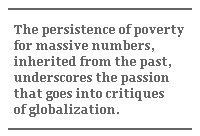
Still, it would be heartless, indeed cruel, to make the performance on poverty reduction an occasion to celebrate liberalization, as much poverty still remains, even when defined minimally in caloric-intake terms. Indeed, the persistence of poverty for massive numbers, inherited from the past, underscores the passion that goes into critiques of globalization. However, the conclusion that flows from a comparative analysis of the trends since the beginning of liberalization in 1975 – when set against the condition prior to it, of staggeringly high poverty and economic stagnation – is different. Higher rates of economic growth, facilitated by periodic doses of liberalization, pushed forward poverty reduction. The policy implication therefore is that more, not less, liberalization fosters and sustains rapid economic growth.
Meanwhile, there has been no marked increase in inequality in terms of hard data; distribution of consumption expenditure to the lowest 20 percent of the population has remained substantially stable. However, there is no doubt that the top 20 percent of the population has benefited enormously from globalization. At the same time, widening of regional disparities in poverty reduction from the Hindi heartland of Uttar Pradesh and Bihar to the booming provinces in the South is of deep concern. On the other hand, the earlier situation of relatively smaller regional disparities was associated with economic stagnation in contrast with the current economic dynamism. Meanwhile, the greater advance by some states should serve as a stimulus to the laggard states to set their own house in order to promote growth.
In short, contrary to the position of the critics, globalization has served as the agent of deliverance for India from economic stagnation and perpetual economic crises even as it has reduced poverty. However, India continues to be dogged by deep-seated societal problems that persisted throughout the autarkic period. But it is precisely the accelerated growth generated by globalization that has provided the additional resources to alleviate, if not yet to remove, them.
Baldev Raj Nayar is Emeritus Professor of Political Science at McGill University, Montreal. This article draws on his heavily documented monograph “India’s Globalization: Evaluating the Economic Impact,” (Washington, DC: East-West Center, 2006), which is being republished by Sage India in 2007.